|
My Thesis involved developing a single utterance, trained, Speech Recognition
System using a LSI-11-03, with an 8 channel analog filter bank and Dynamic Warping matching written in Fortran.
But I had been working on stuff for electric Guitars and Bass, and digital synthesizers. Independantly discovered
the plucked string algorithm with a Signetics 2650 system and later was working on a Z-80 based
system before walking into a little local company.....
Fairlight Instruments - Reinventing Sampler
Fairlight CMI series II
The CMI Series II was a further development of Fairlight Instruments Pty.
Ltd. original sampler and music production system. Working for Peter
Vogel and Kim Ryrie, and with Quentin Goldfinch, we replaced the Graphics,
Floppy disk Controller and Channel Cards. Main difference was the original
sound cards used a switched resistor filter that's clocking rate changed
with sound pitch and sometimes produced what we called B Flat birdies.
The other cards were replaced to use double density disks, and make graphics
1 card instead of 3 and remove any trim pots (and nasty LS123s and LS121s!).
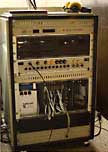
There were a few things developed that never went on sale. A Hard disk
system, rack mounted CMI (above), companding noise reduction and non- music
related such as single board 6809 based office machine workstation.
The series IIX replaced the CPUs
(from dual 6800 to dual 6809), put
in a bigger system memory card (mostly Quentin), and changed the system
software as well (by a new software team of three). All this to move to
Microware's OS9. MIDI was added along the way too, ( mostly by Peter
Farleigh
and Martin Willis). Core software development at that time was Andrew
Canon, Steve Steintz and Michael Carlos. It was a very small team, and we got to meet some interesting people, like Peter Gabriel....
Fairlight CMI series III Design
I was the system architect and lead designer of the electronics in this system. Did the original schematics of all the new boards. Digital, analog systems and the motherboard.
The CMI Series III kept the original disk and graphics, than totally changed
the sound generating system to a shared memory architecture. Added a 68000,
eight 6809s, tons of memory, 16 bit stereo sampling and 16 bit, 16 channel
output. A huge multiprocessor system, that still had to have a lot done
in discrete hardware. That was 24 or so 8x8 inch PCBs in the front 19" wide eurorack card cage.
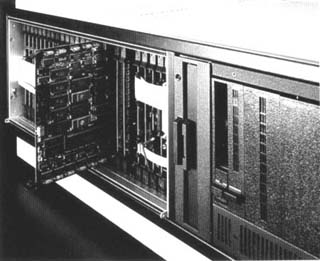
It was actually a virtual memory sampler, except
the original software didn't support streaming from disc. This is now considered
the first modern Sampler.
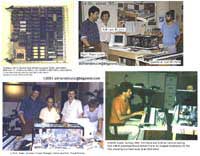
The cards were all originally wire wrapped, above being the channel
card. First CMI III prototype images here. The
channel cards each had their own processor and controlled address generation,
pitches and envelopes for 2 audio channels. The interesting thing about
this was the cards calculated 2 channels of 24 bit addresses 8 bits at
a time in hardware and accessed a common 300nsec synchronous wave memory.
There were 8 slots for memory accesses and that if an audio channel didn't
need it's slot (depending on pitch and if the channel was active or not),
that could be given to other system devices such as the main CPUs, the
68K or data to and from disc.
It was this architecture that allowed the system to grow and change
direction, by allowing the 68K (and later 68030) to become the master and
eventually ditch the main CPUs ( which were 6809Es ), and change from Sampler
to Non Linear Audio Production System as data to and from
disc become more important than playing samples statically from
memory.
More important being related to market charges, where they couldn't
compete with low cost modern Samplers.
The original CMI-III was to be
retrofittable to earlier CMI cases, as
in the prototype photos. There were other design compromises made as
well, but that is the Art of Engineering. Two layers of analog audio
boards against the
back panel.

After seeing what compromises that involved, Peter Vogel
decided
another rear facing Audio rack was a better solution and Ron Huby and
he
repackaged the analog audio electronics with improvements the extra
board
space allowed.
Stereo hard disk recording experiments were done with a visiting Seattle
guy Chris Prall (who is now at the University of Washington) , but we didn't
see the point at the time, as the hard disks were too small and expensive.
So it was more good luck for Fairlight than brilliant foresight on my part.
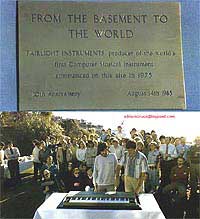
The 10th Anniversary of Fairlight image here.
By this time there were also Computer Video Instrument (Kia Silverbrook's
invention. As in Silverbrook Research and before that, Integrated Arts, Australia's biggest hi-tech startup failure... will history repeat?) and VoiceTracker development teams, but I wasn't involved with
those products. Peter Vogel offered us the role of R&D Manager, so
he would become Technical Director, but we were already making plans to
move on... my reference from Peter Vogel.
The original MFX dumped the music keyboard, and changed the software
to focus on hard disk recording, but we were in Japan by the time that
happened. We have been told it took 8 or 9 years after I left before they
needed to replace the last circuit card that represented the core architecture
we put in place.
I attended an Audio Technology conference in Tokyo some five or so years
after leaving Fairlight and ended up at a dinner table with a Professor
Tsutomu Ohashi. It turned out he was the composer for AKIRA, a landmark
Japanese animated film, and was a huge fan of the Fairlight CMI III. The
100Khz sampling, and the fantastic sound quality was what did it
for him. It is interesting to hear even today, the sound quality hasn't
been beaten in any sampler, and there are some that are still being used....
So why did I leave?
A significant issue was they planned to move the whole company way
out west past Springwood in the Mountains, from the Eastern Suburbs,
and that wasn't for me....... I still have the Fender Squire given as a going away present. ( I get asked that! )
Play it too, visit the Megacurve demos.
I developed several electronic drum circuit boards before moving to Japan. One was a simple ROM
based sample playback unit. The other was variations on the Electronic Synthesizer, SIMMONS Electronic
Drum, sound. Sold a few, and still interested in hearing from anyone still interested in what must now be an 80s sound...
Roland Corporation Japan - DSP, Elastic Audio and Feel

Roland A-880 Midi Patch Bay
A gate array, small battery backed static ram chip and 6802 system. Just
keeps on selling. The midi merger used a bitmap, so that sending multiple
note ons, on the same channel and note got ignored on the output when mixed.
Same code was re-used in A-50 and A-80. Turned out some people made fat
sounds by retriggering multiple voices by the same note and channel.
The first product proposal was actually just a Midi merger box, that
had a pitch bender and some controller inputs, but it was very much something
that another maker already produced. This product was all developed and
working when it was dropped. A very common thing to happen, no matter where
you are.
Roland A-50 and A-80 Midi Keyboard Controllers
The A-50 was done first, and the A-80 was a minor software change. It was
the first Roland product to have a large LCD display and softkeys, but
it wasn't the first to be released. A story in itself. Also first to use
pitch and modulation wheels. Used 2 6802 chips. They were the A series
because Adrian and Aota worked on them (with the help of 5 others). The
remote in was suggested by Ike in marketing in passing and we put it in.
Prototypes had a much lighter aftertouch, but the keyboard mechanism guys
firmed it up as the sensor was more linear that way. You could change 1
resistor on the CPU A board to change the touch back and that mod seems
to have become rather popular. Also did a custom version that got rid of
the SYSEX memory and doubled the number of patches. Very difficult
to manufacture and test with the individual key sensors. Polyphonic Aftertouch
became one of those things the media wanted, but real players couldn't
use. Did sell more than anyone expected, and separate sound modules and
keyboards started to catch on.
The Owners Manual suffers from the problem that it explains how to set
things, but not why, among other things. That all taking up way too much
space. For example, the A-50 allows you to remove Active Sensing from the
output, even if present on inputs, as it would terminate a soundmodule
when muting zones or outputs. All the consequences of options are assumed
to be understood by the highend user. Not always true.
The backlite for the LCD display can be noisy in a quiet studio, and that can also be disabled. Eric Persing's A-50 for example.
Research and Development, Smalltalk, OOP, DSP, Digital Audio Synthesis
Became very involved with Object Orientated Design and Modeling around
1988 and Smalltalk/V was the system used, in conjunction with DSPs, MIDI
and other I/O devices. I built and developed working proof of concept systems.
Human Rhythm and Feel was one
system I worked on for a while. Drum machines couldn't play, or be
programmed to play like Ian Paice, unless you could play like him to
start with and most customers couldn't. Analyzed MIDI phrases and
worked out an algorithm to apply the feel to quantized, robotic
phrases. It gave interesting results, and another group was influenced
(Inspired may be closer to the truth) by this and came up with the R8
Human Drum machine. It was a product before I even knew anyone had paid
any attention to my demos...
Above is a screen shot of a system that controlled and programmed prototype
DSP hardware. A Postscript for sound, that is similar to parts of the MPEG4
spec today.
This embodiment was a virtual analog DSP based modular synthesizer.
Oscillators, Resonant Low Pass, Highpass and Bandpass Filters, envelope
generators, LFOs, Delays, Keyboard MIDI inputs and Amplifiers and Mixers.
I manager to show it to a dozen people. At the time, Roland was against
the concept of producing a
Virtual Analog Synthesizer, as anyone
could see that customers only wanted samplers....
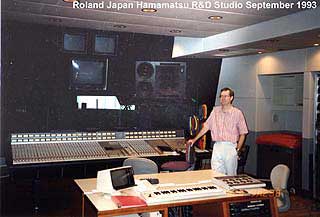
One application I started using this system for was as a singing synthesizer.
The voice was one instrument that wasn't readily available to electronica.
You could use sampled phrases, but they were difficult to manipulate at
the time. I hadn't gotten very far when, again, it was deemed that this
wasn't the direction to go in.....
Later, four Japanese Engineers made a graphically programmed system
adding sampler hardware to the mix and some new custom DSP hardware. A
video was made of this and used as a PR piece to all the overseas dealers
as a technological show piece. COSM later came out of all this, but it wasn't what I had called it.
Involved in quite a few media related projects that I really would like
to continue with. A Silicon Graphics proposal is one that comes to mind
as I type this. Stuff with some SoundDroid developers another. Not a lot
have became products yet. But rival manufacturers have developed and marketed
some similar products over the years.
Phrase Based Music Composition
Some concepts that did make it eventually were the music walkstation
and the phrase based music construction paradigm, which had been a framework for the Human Feel experiments,
and a domestic Japanese video production system.
In there also did artwork, 3D animation for CD-ROM and presentations, and all the other stuff required
for proof of concept to get projects considered for continuation.
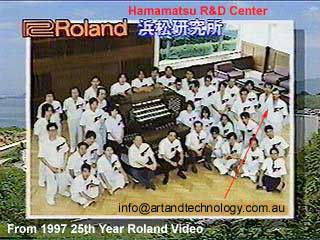
The music Walkstation was going no-where till Yamaha came out with a
VHS tape sized portable unit some time later. That always made a
difference.
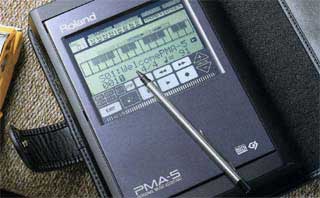
The Music Work Station MPA-5, way before all those iPhone, iPad music applications.
Multimedia, Video and Audio Editing Systems
Multimedia looked interesting in the early '90s and that focused around
Desktop Production. I attended quite a lot of varied production related
things with a guy that was at the Roland LA R&D office when it existed.
Chris Meyer went on to form Cybermotion with his wife Trish and are now
core to the motion graphics field.
There were many others that could be mentioned too. Chas Smith, from
Glasgow, was one of the UK marketing people that had made the place a joy.
He was Vice President of Sales and Marketing (until Oct 2006) at AVID in the USA,
and for some time before that Digidesign.
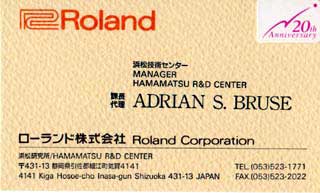
Liquid/Elastic Audio
Realtime Audio Pitch, Time and Formant control was developed with a plug
in DSP Card and Windows based software tools, such as the above Soundmodule
User Interface, data allocation and voice control software. C, C++ and
Class Libraries inheriting the world from Smalltalk. Funny how Java today
could have been Smalltalk if Sun had got the license they had wanted.
Elastic audio allows things like vocal phrases to have new timing and
melodies imposed on them. It also allows sampled audio phrases to
be manipulated to compose or construct music.
Prototyping the concept and demonstrating it working is vital to getting
the go ahead. This requires the touch of Hollywood, and the talents of
musicians like Australian Adrian Scott, an original member of Air Supply.
Variphrase Encoding and Development, V-TrainerOne
Elastic Audio development tool become an application bundled with
V-Producer,
the control software for the VP-9000, and future products. This tool
did the Variphrase encoding, and allowed editing of the makers used to
determine attacks (the none elastic bits) and syllables within phrases,
and things like tempo. A whole lot
of functionality is disabled at compile time for the commercial
version.
A Mac version was also released. Great chunks of code, sweat and blood
(not just from me but, akita, funada, hoshiai, suruhashi, kusekabe,
yamamoto, tomisawa and many others),
also used in standalone systems.
If you ever see the earlier version of V-Trainer windows, look at the
About Window, hold down the control key and click the mouse within 5 pixels
of the top left hand corner of the graphic area.
VP-9000 Variphrase Processor
Elastic Audio became a hardware product with this unit. The original system
was to be the a 1U rack box and require a computer for the user interface
and encoding and connect via USB. Unfortunately, that was before Apple
had any USB equipped systems, and the idea was killed off by insistence
from musician consultants. The stuff users mostly deal with in this type
of product was all developed and simulated using a Mac cross-development
system. Lots of the code is written in C, and that part was developed in
a UNIX environment and cross compiled for the Hitachi processor that runs
the show in the box.
And who used it and for what? Try Daft Punk - One More Time. or technologic for electronica vocals...
There is actually a staff credit roll that is accessed from a debugging
menu. Most products have such Easter Eggs, to use the term from the DVD
world.
The VA-7 arranger keyboard became the second, with a much more cost
effective system architecture. That was developed in a Windows development
environment for a Hitachi MCU.
One thing that can be said, is that software, less hardware, and knowing
what went before, and content, is one path to the future.....
VSynth
April 27 2003
... and I was referring to VSynth. As this is finally out, a year
or so late, it isn't a secret anymore. I didn't have anything directly
to do with the hands on development of this product, other than it must
reuse the encoding stuff we were envolved with. Most likely with modifications
and re-writes. It also combines the virtual analog DSP stuff that I tried
for years to get done as a product, that first happened as the Roland JP-8000.
The Roland VariOS is now a 1U rack with USB connection to a PC
running V-Producer. The main V-Trainer encoder code was in a DLL that is
being used. If you check above, that was going to be the original Variphrase
product concept. It is also software configurable as other types of instruments.
NAMM 2003 showed some old hands like Dave Smith coming out with small
independent interesting products again. I used to meet up
with him at the International Computer Music Conferences. In fact he used
to follow us around when I tried to talk to someone. If the business details
are right, I could be involved with such sound/music products myself.
Moving On....
Why did I leave Japan? Basically the growing nationalism of my boss, Mr Kikumoto, that "Japan is for Japanese!" got too much to put up with. And even though the Chairman, Mr Kakehashi moved me to a team he had, I hoped that my experience being involved with significant Roland Technology between 1987 and 2001 would mean something else where.
I still get New Year cards from Mr Kakehashi, such as this one for 2013 on the Technical Grammy Award for MIDI.

I'm now connected to a few Roland Japan colleagues on Facebook. They were all great guys.
Unfortunately I don't think Roland has done anything particularly interesting since I left. Nothing I've wanted to get or use anyway. All the interesting stuff for me is in performance synths, VST and computer based production systems, or guitar related recording gear.
Interesting to see Eric Persing started Spectrasonics as Roland wasn't interested in where he was going either. They have factories producing the keyboard version of Mainframe Computers.
Seems like a lost opportunity to me, and that Roland's financial results results have been very poor in the 2008 to 2013 period seems to support that. And they haven't got back to me asking for consulting 8^)....
Contracting, Design, Electronics and Software
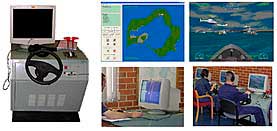
3D Training Simulator: HelmsmanSpent
most of 2002 developing custom industrial systems in Australia, and
having fun doing it. Such as training systems for Electronic Warfare,
Air Traffic Control, Comms, Sonar and Chaffe Launchers. Of the systems
we worked on, the Helmsman has received
the most accolades, isn't an issue of national security, and so is
getting
a mention here.
On time, under budget, documented, built to last, worked
liked it should, and fun to use too. There were no yes-men, inter-departmental
middle mangers, just slow metalwork suppliers. It is a real-time
3D ship simulator to teach procedures to budding helmsman. Six student
stations with a view from the Bridge are connected to an Instructor station
with a Gods view of the harbor that can throw obstacles and bad seas and
weather at them. They communicate with the instructor via voice over TCP/IP.
The students have real boat steering and throttle controllers. My contribution
to this was mechanical / microcontroller / electronics design, project
management and leadership to code, manufacture, document and deliver the
one off system.
The system used modified Morse Controls Helm and Telegraph. The
Telegraph was for actuating cables, so the unit was modified to control
long life potentiometers via toothed belts and pulleys to be able to generate
a value usable by the software.
The system was designed around off the shelf PCs, modified industrial
consoles and a custom micro-controller for controller interfacing. The
PC software was developed in MFC VC++, and used the VTree 3D engine. The
interface controller was based on a PIC16F877A (A very useful little device!). This controller was also
used in the other training systems developed, as the board could be loaded
in various ways, and connected to the PCs via a serial link.
Project Management
Getting things finished requires a framework to organize it all. Project Management, and the variations
required by different types of projects is key. Schedules, effort and costs are monitored and so controlled.
Project Management is getting a mention, as some believe it is an end
unto itself. We don't believe it is. It is however, one of the
important tools in the toolbox to get a job done, like source code
control, a compile, screwdriver, DSO or soldering iron.
Design for Safety
Safety critical devices are designed with failure modes and their probability
of failure in mind. They also use redundancy to fail safely, continue to
operate even with failure, or inform the users that they have failed. There
are international standards covering it all. There are also processes for
development, testing and manufacture to guarantee all this...
spent time working in this area in 2004.... and there is a lot more than
can be said. We are the only one in this country to apply Standards EN50128, EN50126 and EN50129.
Making LOUD, very efficient, vandal proof audio alarms is part of
that world, and here is a small horn loaded unit. A two part aluminum cast
horn was designed around a telephone ear speaker, to produce a Weapon
of Mass Annoyance.
Used SLA to print 3D Solidworks parts for testing, after the Super Sculpey
polymer clay stage refined the design. This little unit produced over 91dB
'A weighted' at 1m with the tones required.
Wi-Fi, DataBases and Data Mining
Automated downloading of data via Wi-Fi (802.11g) and then extracting
useful information was an interesting design concept. Unfortunately, all
the hype surrounding Wi-Fi, it has a tendency to remove the focus from
the real problems to be solved, which were the store and foreword
base stations, the Database design and Data Mining. What we ended up demonstrating
was the first algorithms designed did show up trends that were not
obvious, and had been unseen in 5 to 10 years of using the raw data.
That Excel was the tool used to do the prototyping, and that it was
so successful has very much changed the way we now view it and the SQL
server, MSDE.

Shrink wrapped software development and management.
Recent Examples of Device Development
We developed an Electrophoresis Device, used in DNA research. This required very high voltage control and monitoring, water cooling and be manufactureable.
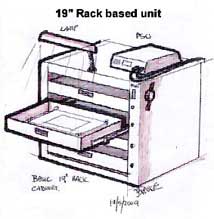
Prototype concept sketch. We work with an automated metal cabinet manufacture to provide custom cases and internal cable tubing moving carriers. The ability to quickly describe visually components has always been a key to smooth communication.

Fabrication and refinement. The initial units used a ceramic tile the German customer insisted on using that we replaced with a custom made subsystem from Kyocera that dramatically simplified the unit by incorporating a trough and wall into the ceramic part.
.png)
The unit is currently the worlds best Electrophoresis system.

We have designed custom audio related test sub systems for very well known manufacturers to simplify their core business. This being a very specific type of audio and power software controlled patch bay. Features custom electronics, firmware, CPLD, metal and plastic case components. Designing the labels and having them manufactured too.
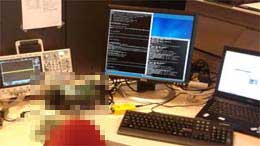
And been brought in to analyse issues too, when not involved with new development. Experience means something.
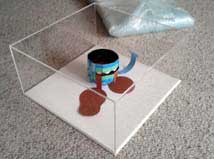
This is one of 5 custom acrylic artwork display cases, with invisible, but removable fastening between the lid and base.
And many other Projects......
We have also been involved in successfully managing huge shrink wrapped commercial software projects, websites, strings of NDA covered scientific, commercial, medical and other devices and systems as a consultant.

Our last big technical development involved LoRa, done over a few years and finished end 2018. SX1276 in original transmitters, gateways and repeaters and all code in C. Also implemented a LoRaWan Client and Server in python, but the production system had a custom system out of the way of the LoRaWan bands. Found LoRaWan end to end performance and reliability very poor. Another example of a Tragedy of the Commons.
I much prefer the Cartooning, Art and Ilustration work!
There was something of a Fairlight reunion at the Memorial for Alan Galt, the guy that designed and made all the wood and metalwork in the Fairlight CMIs, and many other systems.

We now have a short Autobiographical/Historical Sequential Art work covering this and more here: This Is Where The Smoke Comes Out .
Contact us.
Home
Copyright © 1995-2023 Art & Technology. All rights reserved.
No reproduction is permitted without explicit written permission.
|
|









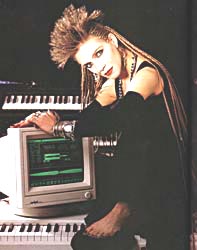
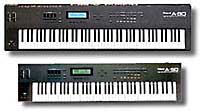
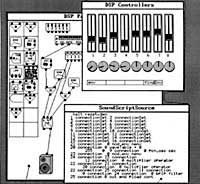











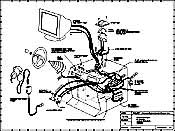





.png)




